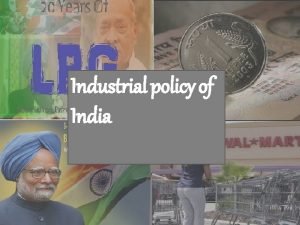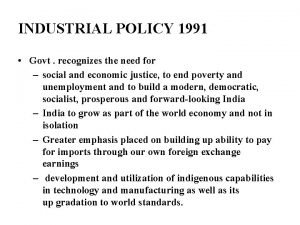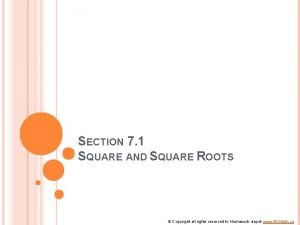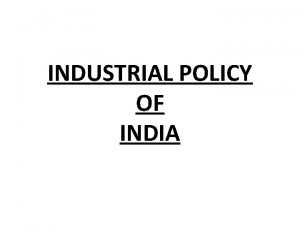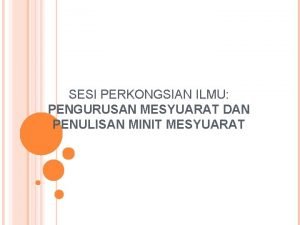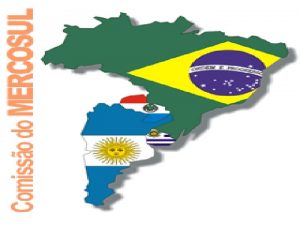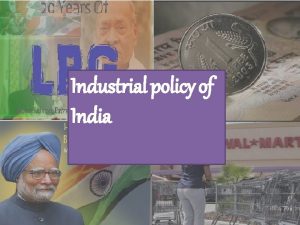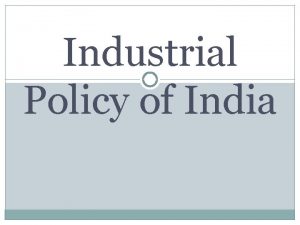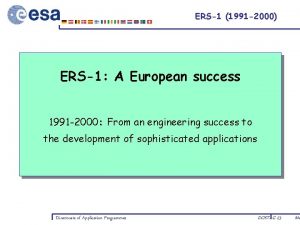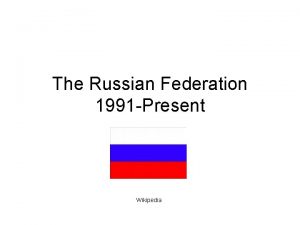INDUSTRIAL POLICY OF INDIA Industrial policy upto 1991












- Slides: 12

INDUSTRIAL POLICY OF INDIA

Industrial policy upto 1991 The Industrial policy of India prior to the liberalization ushered in 1991 was characterized by 1) Reservation of Industries Future development of most of the import industries was exclusively reserved for the public sector Manufacture of a large number of items was reserved for the small scale sector 2) Dominance of Public Sector The policy of the Government was to ensure that the public sector gained control over the commanding heights of the economy The Industrial policy Resolution of 1948 established public sector monopoly 2 of 38

3) Entry and Growth Restrictions There were a number of entry and growth restrictions on the private sector, particularly on the large firms and foreign firms. Large firms had to obtain clearance under MRTP Act, in addition to the industrial licence, for establishing new undertakings. 4) Restrictions on Foreign Capital and Technology The scope of use of foreign capital and technology was limited. Operations of foreign companies in India and issue of secutities abroad by Indian companies were regulated by FERA, 1973

The New Industrial policy, 1991 Background to the new policy announced on July 24, 1991 The new economic policy was necessitated by the worst economic crisis which was never witnessed by India after independence. The most visible sign of the country’s economic crisis was its extremely low foreign exchange reserves of Rs. 2400 crores, reached in early 1991. The reserves were just enough for 3 weeks of import requirements Another major aspect of the economic crisis was the rapidly increasing burden of national debt, which was 60% of GNP in 1991

The New Industrial policy, 1991 As part of the budget of 1991 -92 , the government announced a number of economic reform measures. The new economic policy had four components a) Liberalisation b) Privatisation c) Globalisation d) Stabilisation Together called the Structural Adjustment Programme ( SAP ), the new policy envisages a lot of economic reforms.

Industrial Licensing policy Encourage and assist Indian entrepreneurs to exploit and meet the emerging domestic and global opportunities and challenges. This can be done only if the role played by the Government were to be changed from that of only exercising control to one of providing help and guidance. Industrial licensing abolished for all industries, except those specified, irrespective of level of investment Compulsory licensing for reasons related to security and strategic concerns, social reasons, problems related to safety and over-riding environmental issues, manufacture of products of hazardous nature and articles of elitist consumption

The New Industrial policy, 1991 The Industrial policy announced on July 24, 1991 had enormously expanded the scope of the private sector. 1) Expansion of the scope of Private sector All but 6 industries were freed from licensing • • • Distillation and brewing of alcoholic drinks Cigarettes of tobacco and its substitutes Electronic Aerospace and defence equipment Industrial explosives Hazardous chemicals Drugs and Pharmaceuticals

The New Industrial policy, 1991 2) Removal of MRTPA Restrictions Most of the provisions of the MRTP Act pertaining to concentration of economic power were scrapped. ( Those requiring prior permission for establishment of new undertaking, substantial expansion, manufacture of new items, mergers and acquisions were scrapped ) 3) Liberalisation of Foreign Investment The policy towards foreign capital and technology has been modified very significantly and progressively liberalized. FDI was allowed in majority of the industries, in varying levels, ranging from 26% to 100% of the total equity

3) Liberalisation of Foreign Investment Since 1992 – 93, the Indian stock market is open for investment by Foreign Institutional Investors ( FIIs) Progressive integration of Indian economy with the global economy has been acknowledged as one of the objectives of EXIM policy. The import policy was made more liberal by reducing the tariff levels and procedural reforms The Rupee was made partially convertible on current account and later it was made fully convertible.

Model of Economic management in India Pre-reform strategies Economic reform strategies . Closed economy Open economy . Self reliance Integrate with world markets State led economic growth Market determined econ. Growth Import subst. Strategies Export oriented strategies . License dominated regime Delicencing, deregulation . Frequent state interventions Selective & effective intervene. . Political administered prices Market determined prices . High tax rates Tax reforms

Evaluation of the policy Two questions are relevant in the context of critical assessment of the new economic policy 1) Is the policy unavoidable ? Yes. A lasting solution to the economic crisis was not possible without the restoration of fiscal balance, infusing dynamism and competition. 2)What are the achievements and failures of the policy ? Growth rate of 0. 9% in 91 – 92 to 6. 8% in 96 – 97 Exports have grown comfortably Foreign investment inflow was good, resulting in huge foreign exchange reserves.

Evaluation of the policy 2)What are the achievements and failures of the policy ? Economy has become vibrant. Captains of industry are buoyant and are not deterred by the entry of MNCs There is an overall increase in productivity, quality and competitiveness of Indian goods and services. Contrary to what critics might say, poverty has come down.
 Industrial policy
Industrial policy Industrial policy of 1991 approved
Industrial policy of 1991 approved Is 225 a perfect square
Is 225 a perfect square Construct a diagonal scale of rf 1/4000
Construct a diagonal scale of rf 1/4000 What are all of the perfect squares
What are all of the perfect squares Lcm of 7 8 11 12
Lcm of 7 8 11 12 Industrial policy resolution in india
Industrial policy resolution in india Introduction to industrial relations
Introduction to industrial relations What is industrial relations in hrm
What is industrial relations in hrm Perkara berbangkit dalam minit mesyuarat
Perkara berbangkit dalam minit mesyuarat Microsoft publisher 1991
Microsoft publisher 1991 Amina rashad
Amina rashad Linux 1991
Linux 1991
